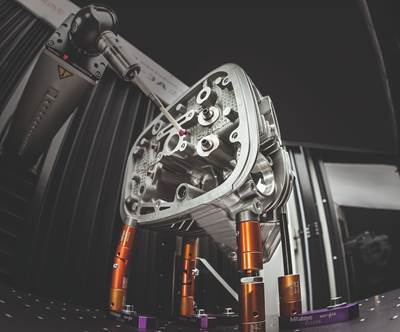Taking A Reading on Gages
Are we taking advantage of the vast amounts of dimensional information that a gage or hand tool can produce? Certainly not if the information presented on the gage display reads only “over,” “under” or “good.”
These three display readings may be okay for many routine inspection jobs, but it just isn’t good enough when precision parts are required. Such a setup doesn’t take advantage of the benefits that can be realized when today’s data collection capabilities are teamed up with dimensional gages and hand tools.
Today’s gages not only make impossible measurements possible, they also overcome human errors such as misinterpretation, short memory, blurred vision or repetition errors. Because much of the data collection workings are basically transparent to the user, he or she is free from the mundane job of writing down or keying in numbers.
For example, imagine measuring gage blocks without the aid of an automated system for writing down sets of measurement. The large amount of recording required for the inspection of the set of gage blocks would be a highly time-consuming process and subject to numerous human errors. Today, the gage block measuring system is connected directly to the computer and special software, making the process fairly automated with templates for block positioning as well as automated data collection and form generation.
This same automated data collection has moved from the inspection lab to the shop floor. There are many reasons why collecting data is important to the manufacturing process: to measure and monitor the manufacturing process, to document the results for quality assurance, or to monitor the gaging to ensure it maintains it performance. However, just as with the gage block example, there is a lot of data to be collected. It must be reliable, and the process must be transparent to the person making the measurement.
In the ‘80s, there was a revolution in electronics in which for the first time, most electronic gages included a data output connector. This allowed for direct connection to a data collection device or computer and it virtually eliminated the errors associated with manual data collection. Thus, a new digital indicator with output could be retrofitted to an existing bench gage via an inexpensive cable. That wasted measurement information suddenly could be collected and tracked. It became crucial to making process decisions.
The machine operator is really becoming a quality technician at the point of manufacture.
In fact, some digital indicators today have virtually the same performance as an electronic bench amplifier but at a fraction of the cost. This turns some basic measuring stands and other gages into high-performance measuring systems that can keep up with the requirements for tighter tolerances. As a result, the machine operator is really becoming a quality technician at the point of manufacture.
However, more control requirements might necessitate more data collection from all gaged dimensions. Herein lies a potential issue for numerous gages and cables to become a mess on the user’s bench. Cables can be tangled, pulled and possibly broken when many devices are working together to monitor the part manufacturing process. This has led to the next generation of electronic updates: moving from wired to wireless data transmission. The technology has moved from add-on wireless transmitters to integrated tools with the transmitter built in. This eliminates the cables, clearing the workstation.
Now data collection is truly transparent since the operator has to do nothing more than measure their parts as they have always done, with only the extra step of pressing a send button on the hand tool to transmit the data. Or, in the case of numerous indicators in a bench fixture, one key switch can collect the information from all the indicators simultaneously and transfer it to the in-house data collection tool.
At one time, this type of data collection was very time consuming, labor intensive and prone to human errors, resulted in more than 5% of data collection errors. This could be a very costly process for high volumes. But with the technology used today, data collection has become transparent to the users, and the data is good and virtually free.
Related Content
Understanding Errors In Hand-Held Measuring Instruments
Different instruments (and different operators) are prone to different errors.
Read MoreHow To Calibrate Your Calipers
If you’re interested in calibrating your own digital, dial or Vernier calipers, here are some steps to take to make sure it goes off without a hitch.
Read MoreHow to Choose the Correct Measuring Tool for Any Application
There are many options to choose from when deciding on a dimensional measurement tool. Consider these application-based factors when selecting a measurement solution.
Read MoreParts and Programs: Setup for Success
Tips for program and work setups that can simplify adjustments and troubleshooting.
Read MoreRead Next
5 Impressions of EMO 2019, from Automated to Autonomous Manufacturing
The robot show? Not quite that. But automation and the expectation of processes that can run unattended if needed are clearly core to manufacturing now.
Read MoreA New Quality Standard You Need to Know About
The Quality Information Framework (QIF) helps connect product data with process data in emerging data-driven environments.
Read MoreObscure CNC Features That Can Help (or Hurt) You
You cannot begin to take advantage of an available feature if you do not know it exists. Conversely, you will not know how to avoid CNC features that may be detrimental to your process.
Read More
















.png;maxWidth=300;quality=90)









